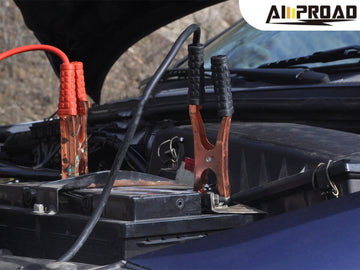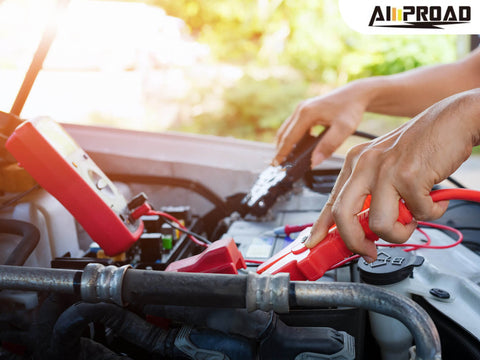
A dead car battery can leave you stranded and frustrated. Thankfully, portable jump starters have become lifesavers for many drivers. But when choosing a jump starter, you might come across two terms: CCA and PCA. Both relate to cranking power, but understanding the difference is crucial for selecting the right one for your needs.
What's CCA (Cold Cranking Amps)?
Cold Cranking Amps (CCA) is a critical rating for any jump starter or battery. This metric represents a battery's ability to deliver a specific amount of current (in amps) at a temperature of 0°F (-18°C) for 30 seconds while maintaining at least 1.2 volts per cell (7.2 volts for a 12-volt battery). Essentially, CCA measures how well the jump starter can crank an engine in cold weather conditions.
Cold weather can significantly affect battery performance. Low temperatures cause engine oil to thicken, increasing the resistance that the starter motor must overcome to start the engine. Additionally, chemical reactions within the battery slow down in the cold, reducing its efficiency. Therefore, a higher CCA rating indicates a better ability to start an engine under these challenging conditions. For those living in regions with harsh winters, prioritizing CCA is essential. It ensures that the jump starter has sufficient power to turn over the engine despite the thickened oil and reduced battery efficiency.
What's PCA (Peak Cranking Amps)?
Peak Cranking Amps (PCA) is another important rating to consider. PCA refers to the maximum burst of current a battery booster can deliver for a very short duration, typically a few seconds. This rating is crucial for overcoming the initial surge of power needed to start a completely dead or heavily drained battery. Unlike CCA, which focuses on sustained power in cold conditions, PCA measures the jump starter's ability to provide a quick, intense burst of energy.
This short burst of energy can be particularly useful if your car battery is completely drained, as it requires a significant initial jolt to get the starter motor turning. High PCA is advantageous in situations where the battery has minimal residual charge, providing the necessary push to initiate the cranking process.
CCA vs. PCA, Which Should You Prioritize?

Choosing between CCA and PCA depends on various factors, including your climate, vehicle type, and driving habits. Here’s a detailed look at when to prioritize each:
Prioritize CCA if:
-
You Live in a Cold Climate: If you live in an area with harsh winters, CCA becomes crucial. Cold weather significantly impacts battery performance, and a high CCA rating ensures your jump starter can provide the necessary power to start your vehicle in freezing temperatures.
-
You Have a Larger Engine: Vehicles with larger engines, such as trucks or SUVs, require more cranking power. Higher CCA ratings are better suited for these types of vehicles, ensuring reliable starts even when the engine oil is thick and the battery is under strain.
-
Frequent Short Trips: If you often take short trips, your car battery might not have enough time to fully recharge between starts. Over time, this can lead to a drained battery. A jump starter with a high CCA can help you start your car reliably in these situations.
Prioritize PCA if:
-
You Live in a Warm Climate: In warmer climates, cold starts are less common, reducing the need for a high CCA rating. PCA becomes more relevant, ensuring that your jump starter can provide a quick burst of power when needed.
-
You Drive a Smaller Car: Smaller cars with less demanding engines do not require as much cranking power. A jump starter with a high PCA rating can still effectively start these vehicles without the need for high sustained current.
-
Occasional Use: If you primarily need a portable jump start for occasional use in mild weather conditions, a higher PCA rating can be sufficient. It provides the necessary power to start your vehicle in most situations without the need for high CCA.
Additional Considerations
While CCA and PCA are important, other factors should also influence your decision when selecting a jump starter:
Battery Capacity (mAh)
The capacity of a jump starter's internal battery, measured in milliamp-hours (mAh), is akin to its "fuel tank." A higher mAh rating means the jump starter can provide more jumps on a single charge. This is particularly useful if you need to jump-start your vehicle multiple times before recharging the jump starter.
Safety Features
Safety is paramount when dealing with high currents. Look for jump starters with built-in safety features such as reverse polarity protection, which prevents damage if the cables are connected incorrectly. Other useful safety features include over-current protection, short-circuit protection, and over-voltage protection.
Portability and Size
The size and weight of the jump starter can affect its portability. Smaller, lightweight models are easier to store in your vehicle and handle during emergencies. However, ensure that the compact size does not compromise the necessary power ratings (CCA and PCA) you need.
Additional Features
Many modern jump starters come with additional features such as USB ports for charging mobile devices, built-in flashlights, air compressors, and more. These extras can add value and convenience, especially if you frequently travel or go on road trips.
Brand Reputation and Reviews
Selecting a reputable brand with positive customer reviews can provide peace of mind. Established brands are more likely to offer reliable products with good customer support. Reading reviews can also provide insights into the real-world performance and durability of the jump starter.
Practical Scenarios and Examples
To further illustrate when to prioritize CCA or PCA, consider the following practical scenarios:
-
Winter Commuter: John lives in Minnesota, where winter temperatures often drop below freezing. He drives a large SUV and frequently takes short trips around town. For John, a jump starter with a high CCA rating is essential to ensure his vehicle starts reliably in the cold and when the battery is not fully charged from short trips.
-
Southern Road Tripper: Sarah lives in Florida and drives a compact sedan. She often goes on road trips across the state, where the temperatures are warm year-round. For Sarah, a booster batterie with a high PCA rating is sufficient, providing the necessary burst of power to start her car in most situations.
-
Occasional User: Mark lives in California and drives a midsize car. He only needs a jump starter for occasional use, such as when he accidentally leaves his lights on. A model with a balanced CCA and PCA rating will work well for him, ensuring reliable starts without overemphasizing either factor.
Choosing the Right Jump Starter: A Step-by-Step Guide
To help you choose the right jump starter, follow these steps:
-
Assess Your Climate: Determine the typical weather conditions in your area. If you live in a region with harsh winters, prioritize CCA. In warmer climates, PCA might be more important.
-
Evaluate Your Vehicle: Consider the size and type of your vehicle. Larger engines require more cranking power, so a higher CCA rating is beneficial. Smaller engines can make do with higher PCA ratings.
-
Analyze Your Driving Habits: Think about your driving habits, including the frequency of short trips and the likelihood of your battery draining. Frequent short trips and potential battery drains necessitate higher CCA.
-
Check Battery Capacity (mAh): Ensure the jump starter has sufficient capacity to provide multiple jumps on a single charge. This is especially important if you anticipate needing to jump-start your vehicle several times.
-
Prioritize Safety Features: Look for essential safety features like reverse polarity protection, over-current protection, and short-circuit protection to ensure safe operation.
-
Consider Portability and Size: Choose a jump starter that is easy to store and handle. Ensure that its size and weight do not compromise its power ratings.
-
Look for Additional Features: Extra features like USB charging ports, built-in flashlights, and air compressors can add value and convenience. Determine which features are important to you.
-
Research Brands and Reviews: Select a reputable brand with positive customer reviews. This ensures reliable performance and good customer support. Consider AMPROAD, a trusted brand offering a wide range of high-quality jump starters.
By following these steps and understanding the role of CCA and PCA, you can confidently choose the right jump starter and be prepared for any dead battery situation.
Jump Starter Implications and Maintenance

Understanding the real-world implications of how to boost a car using a jump starter and how to maintain it can enhance its longevity and effectiveness:
Regular Maintenance
- Keep It Charged: Regularly charge your jump starter to ensure it's ready for use when needed. Most manufacturers recommend recharging every 3-6 months, even if it hasn't been used.
- Store Properly: Store the jump starter in a cool, dry place. Extreme temperatures, both hot and cold, can affect its battery life and performance.
- Inspect Cables and Clamps: Periodically check the cables and clamps for any signs of wear or damage. Damaged components can hinder performance and pose safety risks.
Practical Usage Tips
- Follow Manufacturer Instructions: Always read and follow the manufacturer's instructions for using the jump starter. Improper use can damage your vehicle's battery or electrical system.
- Ensure Proper Connections: Make sure the clamps are securely connected to the correct battery terminals (positive to positive, negative to negative) to prevent reverse polarity issues.
- Use in Well-Ventilated Areas: Jump-starting generates sparks, which can be dangerous in enclosed spaces. Always use the jump starter in a well-ventilated area to reduce the risk of fire or explosion.
Make Your Choice
Selecting a jump starter involves understanding and balancing various factors, primarily CCA and PCA. For most drivers, especially those in colder climates or with larger vehicles, prioritizing CCA ensures reliable performance in harsh conditions. However, PCA remains important for providing the necessary initial burst of power, particularly in milder climates or for smaller vehicles.
In addition to CCA and PCA, consider battery capacity, safety features, portability, additional functionalities, and brand reputation when making your decision. By comprehensively evaluating these aspects, you can select a jump starter that meets your specific needs and ensures you're never left stranded with a dead battery.
Understanding the nuances between CCA and PCA allows you to make an informed choice, ultimately enhancing your vehicle's reliability and your peace of mind. Whether you're facing a cold winter morning or simply need a quick boost in warm weather, the right jump starter can make all the difference.



